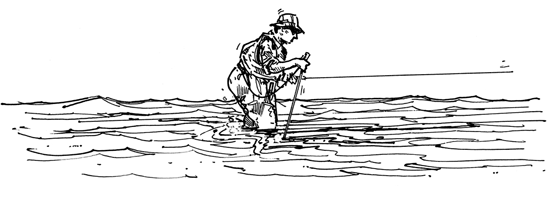Wading Basics

Use your staff to check ahead for changes of depth or obstacles. Keep a wide stance. Feel along with each foot and find a secure spot before you commit your weight to it.
SMART WADING begins with common sense.
Don’t wade unnecessarily. Wading is not appropriate in all waters. The fish are much less likely to be alerted to your presence if you stay out of the water. The pressure wave you create as you wade spooks fish, especially in slower pools.
Wade with respect for the fish and other anglers. Every step you take disturbs the aquatic ecosystem. Avoid weedbeds; they are the condos for the bugs. Avoid wading through spawning redds. Be mindful of how your wading affects nearby anglers. Your wading can stir up the bottom and impact the fishing downstream.
Take appropriate safety precautions. A wader belt is as important as a seatbelt. Buckle up every time you go out and cinch it high on your chest in deeper water to trap as much air as possible and prevent water from coming in. Wear footwear that increases traction.
Use a wading staff. In rocky freestone water, with varying depths and current velocity, the angler with a staff will outfish the wader without a staff every time and will swim less.
Lean into the current. Always plant your staff upstream of your body, leaning into the current. Should you begin to lose your balance, the current will push you upright rather than downstream.
Keep your body sideways to the current. Facing directly upstream or down exposes you to the full force of the water and makes it difficult to maintain your balance.
Shuffle. Move your feet along the bottom as though you are blind. Use your staff to check ahead for changes of depth or obstacles. Keep a wide stance. Feel along with each foot and find a secure spot before you commit your weight to it.
Know your limits. When the water reaches your knees, wading becomes more difficult. If you have limited wading skills, don’t go in above your knees in fast water. The deeper the water, the more buoyant you become and the less traction you have. There is a point of no return, when you are at the mercy of the current, even if your feet are still touching the bottom. Learn to anticipate that point and to stop before you reach it.
Conserve energy. Cross on a slight downstream angle wherever possible. When fishing upstream, walk the bank or in the slow currents along the side and use the eddies created by rocks in the current to ease your passage. Move from eddy to eddy in a bouldery river. Those little pockets of still water below rocks give you a moment’s rest. Go around boulders, rather than up and over them. The less climbing the better.
Plan your route. Look downstream for obstacles and hazards you will have to deal with if you lose your footing. If there is particularly hazardous water below, consider crossing or wading elsewhere. Think about what you’ll do if you’re swept away. Look for the places where you might get into an eddy. Look for obstacles that might trap or injure you.
Don’t die for your tackle. If you are swept off your feet, you might be able to tuck your rod butt down into the front of your waders or throw it to shore, but don’t risk your life for a rod. Your recovery will be considerably easier with both hands free.
Practice swimming with your waders on — in a river or swimming pool. This helps to mentally prepare you in case you fall in. Have a friend nearby for safety.
 Learn to self-rescue. If you fall in fast water, turn on your back and imagine that you’re a drift boat: Your feet become the bow, your head the stern, and your arms the oars. Scan the water downstream, pointing your feet at the obstacles you want to avoid and backstroke into the current with your arms. Position your body at 45 degrees into the current and stroke toward the shore. Backstroking will move you away from any obstacle downstream and toward the shore in a relatively straight line. Wait until you are in slow water before you try to stand. Get out of the cold water as fast as possible.
Learn to self-rescue. If you fall in fast water, turn on your back and imagine that you’re a drift boat: Your feet become the bow, your head the stern, and your arms the oars. Scan the water downstream, pointing your feet at the obstacles you want to avoid and backstroke into the current with your arms. Position your body at 45 degrees into the current and stroke toward the shore. Backstroking will move you away from any obstacle downstream and toward the shore in a relatively straight line. Wait until you are in slow water before you try to stand. Get out of the cold water as fast as possible.
Remember the acronym WADER. Wear your wader belt. Assess the difficulty and anticipate the problems. Develop a plan. Execute that plan. Retreat if necessary.











